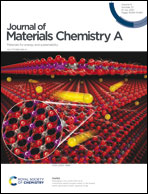Electroconductive nanofibrous membranes with nanosheet-based microsphere-threaded heterostructures enabling oily wastewater remediation†
Abstract
Water pollution caused by oil has placed a significant burden on the ecosystem and human health. However, the present membranes suffer from a serious oil fouling issue during long-term oily wastewater remediation, which has limited their practical applications. Herein, inspired by the taro leaf, we develop a biomimetic nanofibrous membrane composed of BiOBr microspheres anchored on electroconductive SiO2/polyaniline (PANI) core–shell nanofibers. Due to the surface multiscale structures and hydrophilic matrix, the biomimetic membrane shows intriguing superhydrophilicity, underwater superoleophobicity, and low-oil-adhesion. Benefitting from the high porosity and sub-micrometer pores, the membrane exhibited superior capability for separating highly emulsified oil-in-water emulsions with a promising permeation flux of 6140 L m−2 h−1 and a high separation efficiency (total organic carbon content <5 mg L−1). Importantly, the presence of BiOBr/PANI heterojunction arrays with visible light catalytic activity and 3D PANI electroconductive networks effectively imparts desirable self-cleaning properties, maintaining a high flux recovery ratio >98%. The synthesis of such biomimetic nanomaterials may open up new avenues for developing high-performance separation materials for the purification of large volumes of wastewater.



 Please wait while we load your content...
Please wait while we load your content...